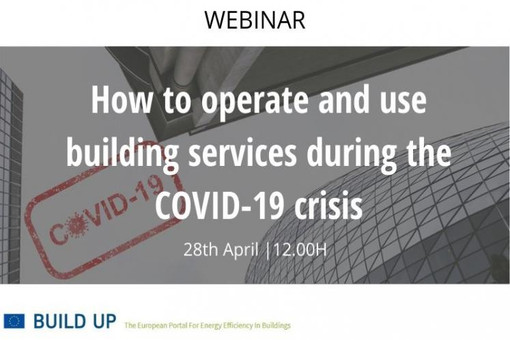This webinar explored with top experts key notions about indoor environments (Indoor Environmental Quality, IEQ), how building services can help prevention and mitigation today and furthermore enable and facilitate the lockdown reversal, and how to best let go of our old habits and create new long-lasting ones good especially during times of crisis and moreover always for maximising health, wellbeing, productivity etc.
We are living very strange times which demand us to stay indoors even more than usual (80% > 95% > 100%) and for some of us a great deal more (50% > 95% > 100%). This experience is enabling a more salient observation of our indoor environment which otherwise often goes unnoticed as we humans adapt, especially when distracted by our preoccupations, whatever they may be. In world areas with a COVID-19 outbreak it manifests:
- In the residential context for most of the general population (non-essential active and retired) facing lockdown measures;
- In the non-residential context for our brave heroes (essential active and reactivated population) facing the crisis in the front line.
As soon as we start reversing the lockdown measures the non-residential context would gain evermore attention as it will be the meeting place of people which will need to be safe and risk free, otherwise already at perception level we will have difficulties returning to our previous habits, or maybe we should create new habits altogether.
The relationship between our indoor environment and our health, wellbeing, comfort, productivity is attaining a stronger empirical basis with each passing year. Now with the COVID-19 crisis it goes to a different level as it passes from “plain” building services delivering us with what we need to conduct indoor activities to “crucial” building services needed for prevention, reduction and mitigation of virus spread.
Against this backdrop one can now easily and clearly observe the crucial role of building professionals, responsible for the design, installation, operation and maintenance of our building systems, and how they can contribute to limit the infection risk due to airborne viruses and contaminated surfaces in buildings by using proper ventilation and cleaning strategies.
The knowledge basis includes among others the following:
- “An analysis of the transmission modes of COVID-19 in light of the concepts of Indoor Air Quality” paper (link)
- REHVA COVID-19 Guidance Document (link)
- “How to operate and use building services in order to prevent the spread of the coronavirus disease (COVID-19) virus (SARS-CoV-2) in workplaces”;
- AICARR (link)
- POSITION PAPER ON HVAC SYSTEM OPERATION DURING SARS-COV2-19 EMERGENCY
- PROTOCOL FOR RISK REDUCTION OF SARS-COV2-19 DIFFUSION WITH THE AID OF EXISTING AIR CONDITIONING AND VENTILATION SYSTEMS
- Mobistyle project (link)
- Motivating end-users behavioral change by combined ICT based tools and modular information services on energy use, indoor environment, health and lifestyle.
More crises to address
Many people state that there will be a difference between the time before and after this COVID-19 crisis. This can be doubted as we have many other global challenges. Challenges that are for now silenced and impacted by this crisis but will emerge very soon again.
The climate crisis
European Union leaders have agreed that the bloc’s coronavirus economic recovery plan should take heed of its aim to fight climate change. The 27 EU leaders agreed to coordinate a coronavirus economic recovery plan. Although the details of the plan itself still have to be worked out, a statement said they had agreed that it should be consistent with the “green transition”, the phrase the EU uses to describe the aim of reducing emissions that heat the planet. The EU’s executive commission wants its 27 member states to sign up at a summit in June to plans to make the entire bloc greenhouse gas neutral by 2050.
Building professionals are talking at global level
We can learn and benefit from our professional around the globe. In the slipstream of these crises, some anti-global sentiments have been observed. However, threats due to the climate change and infectious diseases are global. They can only be addressed and solved at global level e.g. new insights, vaccines and technical solutions to conquer these threats. The REHVA Guidance Document reflects this well as it was prepared and is constantly updated in cooperation with experts active at global level e.g. IEQ-GA (link) experts and furthermore long standing history international cooperation (link).
Programme:
- Introduction by Build Up moderator
- 12h05 - 12h20 – Manuel Carlos GAMEIRO DA SILVA, Prof., University of Coimbra, Vice President REHVA
- Indoor Air Quality (IAQ) concepts: case study COVID-19
- 12h20 -12h35 – Jarek KURNITSKI, Prof., Tallinn University of Technology, Chair of TRC REHVA
- REHVA guidance for preventing the spread of the coronavirus disease (COVID-19) virus (SARS-CoV-2)
- 12h35 - 12h50 – Livio MAZZARELLA, Prof., Politecnico di Milano, REHVA Fellow
- Showcasing the Italian COVID-19 guidance for reducing the diffusion risk of SARS-CoV-2
- 12h50 - 13h05 – Jure Vetršek, Researcher & Project Manager, Institute for Innovation and Development of University of Ljubljana (IRI UL), Mobistyle expert
- People-centric approach: create lasting habits for threat mitigation
- 13h05 - 13h28 – Moderated Q&A
- Closing remarks by Build Up moderator

